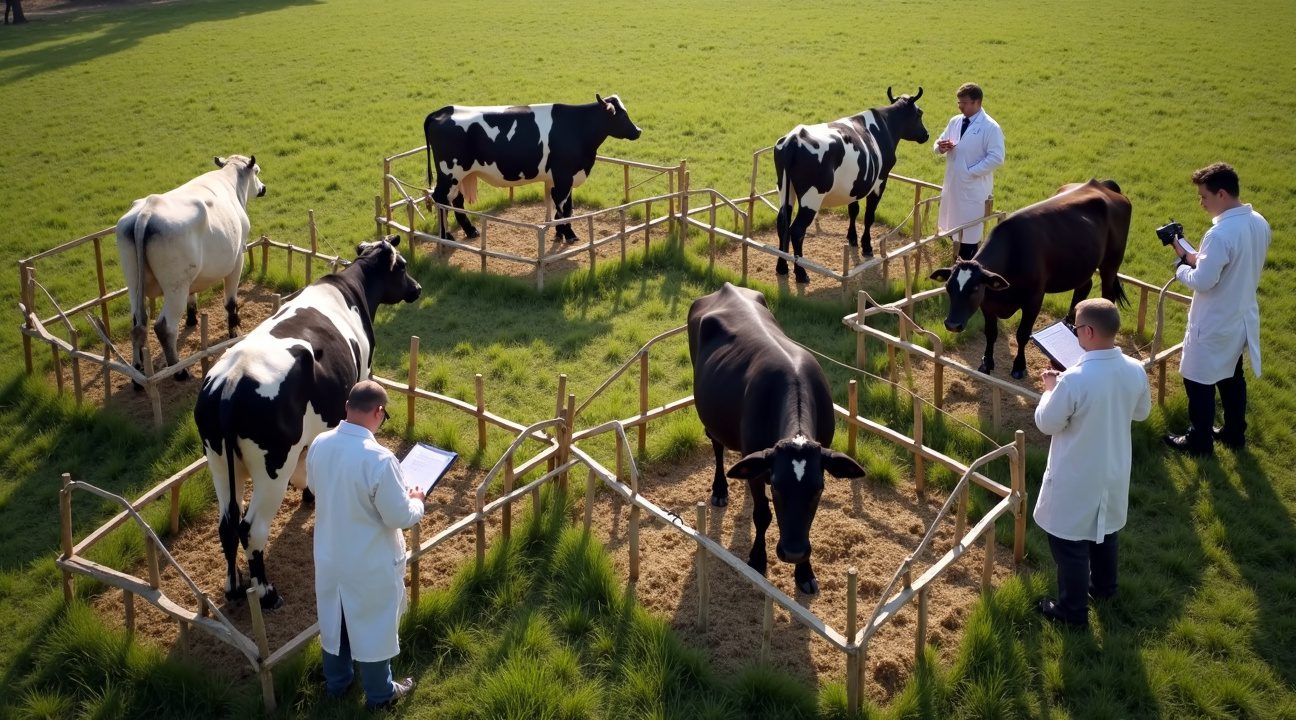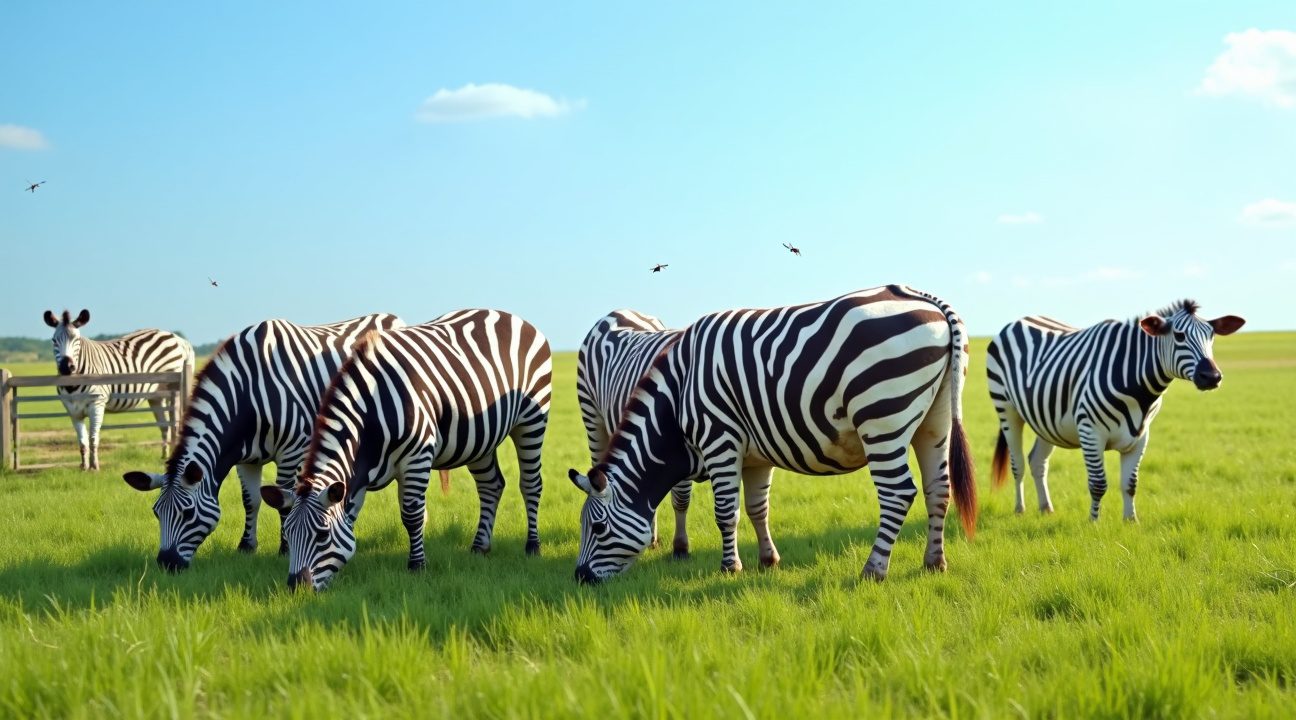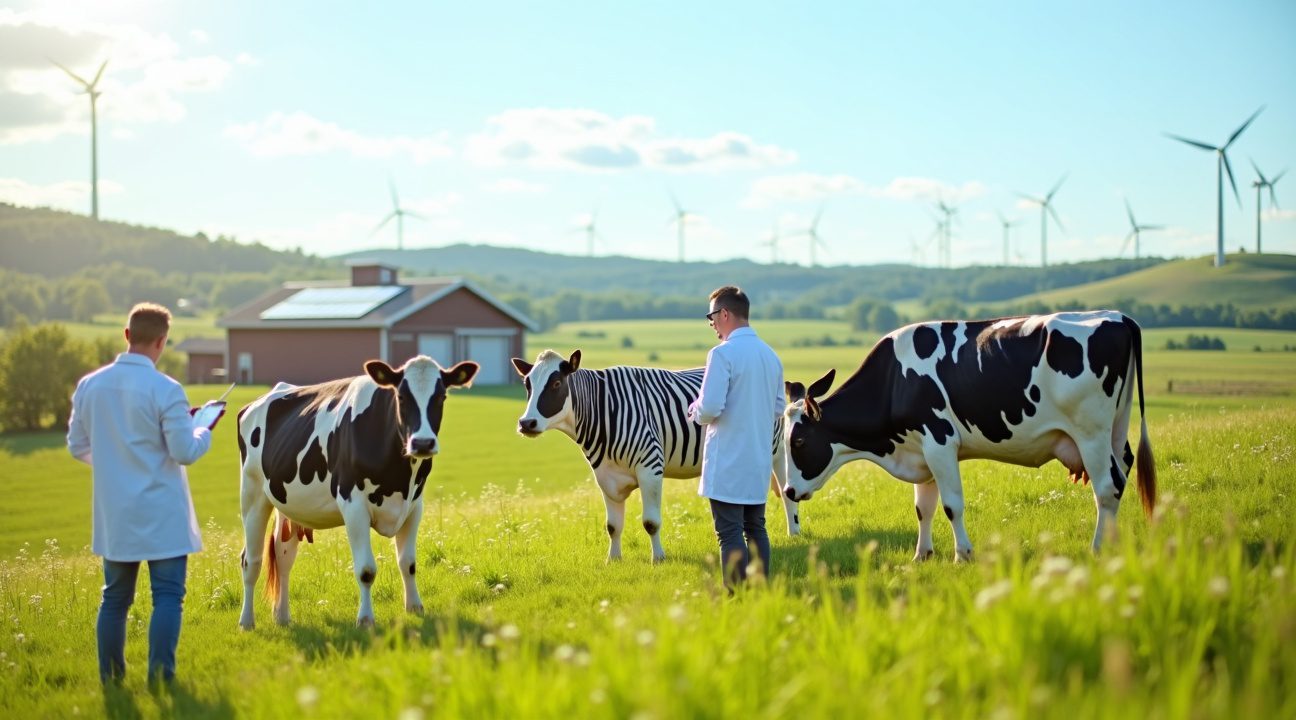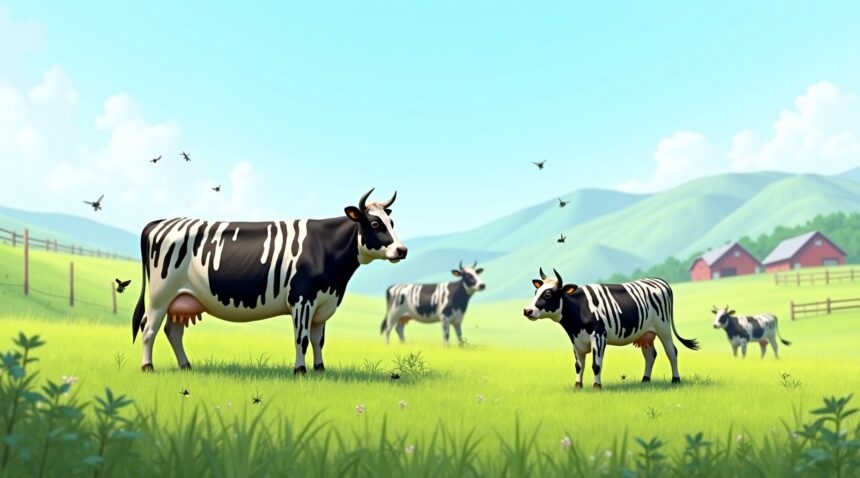Japanese researchers have unearthed a creative and eco-friendly breakthrough: painting cattle with zebra-like stripes can slash biting fly attacks by 50 percent, offering a non-chemical alternative to protect livestock and reduce economic losses.
Key Takeaways
- Zebra-stripe patterns reduce fly attacks by 50% compared to unpainted cattle or those with only black stripes, proving that the black-and-white contrast is essential for effectiveness.
- The method significantly decreases cattle stress behaviors, reducing defensive actions like head throws, tail flicks, and ear beats from 53–54 instances to just 39.8 instances per 30-minute period.
- Visual confusion disrupts fly navigation systems, as the contrasting stripes interfere with insects’ depth perception and landing calculations through light polarization effects.
- Implementation is cost-effective and simple, requiring only waterborne lacquers applied in 5–10 centimeter stripes that last 2–4 weeks and can be integrated into routine livestock management.
- Environmental benefits include reduced chemical dependency, eliminating the need for repeated insecticide applications while protecting beneficial insects and preventing pesticide resistance development.
Scientific Recognition and Practical Impact
The study, published in the journal PLOS ONE, received the prestigious 2025 Ig Nobel Prize in Biology. The award highlights humorous yet impactful research that spurs curiosity and innovative thinking. By mimicking a natural defense seen in zebras, this approach provides a unique solution tailored for real-world agricultural challenges.
Addressing the Economic Toll of Biting Flies
Biting flies contribute to an estimated $2 billion in annual economic damage in the U.S. cattle industry due to reduced milk output, lower weight gain, and costly anti-insect efforts. The stripe technique offers a significant opportunity to curb these losses with minimal intervention.
Integration with Sustainable Farming Practices
This method aligns with environmentally sustainable farming goals. Unlike insecticides, zebra-striping poses no threat to pollinators or other beneficial insects, and it minimizes ecosystem impacts while maintaining animal comfort and productivity.
Painting Cow Stripes Cuts Fly Attacks in Half
Japanese researchers have made a breakthrough discovery that could revolutionize livestock pest management. I’ve found their research particularly fascinating because it demonstrates how nature’s own defense mechanisms can be applied practically in farming. The study reveals that painting cows with zebra-like black-and-white stripes reduces biting fly attacks by approximately 50% compared to unpainted cattle.
The Science Behind Striped Protection
The effectiveness of this method lies specifically in the black-and-white zebra pattern. I observed from the research that black stripes alone produced no significant reduction in fly landings compared to completely unpainted cows. This finding suggests that the contrasting pattern itself creates the protective effect, rather than simply the presence of paint or color on the animal’s hide.
Japanese Black cows served as test subjects in controlled experiments that validated these remarkable results. The researchers documented precise measurements showing the dramatic difference between treated and untreated animals. What makes this discovery even more compelling is its consistency across multiple test scenarios.
Measurable Behavioral Changes
Beyond counting fly landings, the study tracked defensive behaviors that cattle naturally exhibit when pestered by insects. These behaviors provide crucial insight into animal welfare improvements:
- Head throws decreased significantly in zebra-striped cows
- Tail flicks reduced substantially compared to control groups
- Ear beats dropped markedly in painted animals
- Overall stress indicators showed measurable improvement
Unpainted cows and those with only black stripes averaged 53-54 defensive behaviors per 30-minute observation period. In contrast, zebra-striped cows displayed only 39.8 such behaviors during the same timeframe. This represents a statistically significant reduction that translates to improved comfort and potentially better productivity for livestock.
The implications extend beyond animal welfare. Farmers currently rely heavily on chemical insecticides to protect their herds from biting flies. These zebra stripe patterns offer a non-toxic alternative that could reduce dependency on potentially harmful chemicals.
I find the practical applications particularly promising for sustainable farming practices. The paint-based solution requires minimal equipment and can be applied during routine livestock handling. Unlike chemical treatments that require repeated applications and carry environmental concerns, the striped pattern remains effective until the paint naturally wears off.
Cost considerations make this approach attractive to farmers operating on tight margins. Paint costs significantly less than ongoing insecticide purchases, especially when factoring in the reduced need for chemical treatments throughout the grazing season. The labor requirements remain manageable since application can coincide with other routine cattle management activities.
Environmental benefits extend beyond individual farms. Reduced insecticide use means less chemical runoff into waterways and decreased impact on beneficial insect populations. This approach aligns with growing consumer demand for more sustainable agricultural practices while maintaining effective pest control.
The research validates what nature has already perfected through evolutionary processes. Zebras developed their distinctive stripes as protection against biting insects, and now farmers can harness this same principle for livestock management. The 50% reduction rate demonstrates that biomimicry can provide practical solutions to agricultural challenges.
Implementation appears straightforward for most farming operations. Standard livestock paint designed for animal marking can be adapted for stripe application. The pattern doesn’t need to be perfect – the contrast between black and white creates the desired visual effect that confuses or deters flying insects.
This discovery represents a shift from reactive chemical treatments to proactive visual deterrents. Rather than killing flies after they’ve already bothered livestock, the striped pattern prevents initial contact. This prevention-based approach could fundamentally change how farmers approach pest management in their herds.
Two Billion Dollar Problem Could Get Cheaper Solution
Biting flies inflict a staggering economic blow on the U.S. cattle industry, causing losses exceeding $2 billion annually. These persistent pests disrupt normal cattle behavior by reducing grazing time, interfering with feeding patterns, and preventing adequate rest periods. The constant harassment forces cattle to expend energy on defensive behaviors rather than productive activities like weight gain and milk production.
Farmers currently battle this expensive problem through chemical insecticides, but Japanese researchers discovered that painting cows with zebra-like stripes offers a revolutionary alternative. This innovative approach delivers a 50% reduction in biting fly attacks without requiring any toxic chemicals. I find this solution particularly compelling because it addresses multiple problems simultaneously.
Benefits Beyond Pest Control
The zebra-stripe method creates several advantages that extend far beyond simple fly reduction:
- Eliminates the need for repeated insecticide applications, cutting chemical costs significantly
- Reduces worker exposure to potentially harmful pesticides during application
- Prevents contamination of milk, meat, and surrounding environments
- Avoids contributing to pesticide resistance development in fly populations
- Improves animal welfare by allowing natural behaviors without chemical stress
Chemical insecticides create a costly cycle where farmers must continually increase applications or switch to more expensive products as resistance develops. Flies adapt quickly to these treatments, forcing producers into an expensive arms race that benefits chemical companies more than livestock operations.
The stripe painting technique breaks this cycle entirely. Flies rely on visual cues to locate hosts, and the contrasting black and white patterns confuse their targeting systems. This biological approach works consistently because it exploits fundamental insect behavior rather than attempting to poison the pests.
Stress reduction represents another crucial economic factor. Cattle subjected to constant fly harassment show elevated cortisol levels, reduced immune function, and decreased feed conversion efficiency. These stressed animals require more resources to maintain body weight and produce less milk or slower weight gains. By providing relief from biting insects, the stripe method allows cattle to focus energy on productive activities rather than defensive behaviors.
Environmental benefits also translate to economic advantages. Reduced insecticide use protects beneficial insects like pollinators and natural predators that help control other agricultural pests. This preservation of ecological balance can reduce overall pest management costs across farming operations while maintaining compliance with increasingly strict environmental regulations.
How Scientists Tested the Zebra Trick
I found the research methodology behind this fascinating discovery quite straightforward yet comprehensive. The scientists employed a 3 × 3 Latin-square design to ensure reliable results while accounting for individual cow differences and environmental factors.
The Experimental Setup
Six cows participated in this carefully controlled study, with each animal rotating through three distinct treatments over the course of the experiment. Each cow experienced black-and-white painted stripes mimicking zebra patterns, black painted stripes only, and no stripes at all as the control condition. This rotation system eliminated potential bias from individual cow characteristics or preferences.
The researchers counted flies using two complementary methods that provided both immediate and detailed data. Direct behavioral observation allowed scientists to monitor fly activity in real-time, while photographic analysis captured precise moments for later examination. Additionally, sticky boards strategically placed around the test area trapped flies for detailed species identification.
The fly counting revealed fascinating insights about which species pose the greatest threat to cattle:
- Stable flies (Stomoxys calcitrans): 77.9% of all captured specimens.
- Horn flies (Haematobia irritans): 21.5% of captured flies.
- Horse flies (Tabanus sapporoensis): 0.5% of the total caught.
This species breakdown proved crucial for understanding why the stripe treatment worked so effectively.
I discovered that stable flies, being the most abundant species in the study, are particularly aggressive biters that can significantly impact cattle comfort and productivity. These flies cause considerable stress to livestock, often leading to reduced feeding time and weight gain. Horn flies, while less numerous, also contribute to cattle distress through their persistent biting behavior.
The Latin-square design provided statistical rigor that strengthened the study’s conclusions. Each treatment period lasted long enough to observe meaningful fly behavior patterns while preventing long-term effects from influencing subsequent treatments. Japanese researchers discovered that this systematic approach eliminated variables that might otherwise skew results.
The photographic analysis component added another layer of precision to the fly counting process. Researchers could review images multiple times to ensure accurate counts and verify species identification. This dual-method approach provided confidence in the data while allowing for quality control throughout the study period.
Behavioral observation sessions followed standardized protocols, with trained observers recording fly landing attempts, successful landings, and feeding behaviors. The consistency of these observations across all treatment periods ensured that differences in fly activity could be attributed to the stripe treatments rather than observer variation.
The sticky board placement followed strategic patterns around each test cow to capture flies attempting to approach from different angles. These boards not only provided species identification data but also served as an independent verification method for the observational counts.
I noticed that the researchers chose their observation periods carefully to capture peak fly activity times. Most biting flies are most active during specific parts of the day, and the study design accounted for these natural behavior patterns. This attention to timing details strengthened the validity of the comparative data between treatments.
The species identification process revealed why certain stripe patterns proved more effective than others. Stable flies, being the dominant species, showed the strongest response to the visual disruption created by black-and-white stripes. Their visual systems, adapted for detecting suitable hosts, became confused by the stripe patterns in ways that solid black stripes couldn’t achieve.
Temperature, humidity, and wind conditions were monitored throughout the study to ensure that environmental factors didn’t influence the results. The researchers documented these variables to rule out weather-related changes in fly behavior that might mask or enhance the stripe treatment effects.
Statistical significance testing confirmed that the observed differences weren’t due to chance variations. The Latin-square design provided sufficient data points for meaningful statistical analysis while controlling for individual animal and temporal variations that might otherwise complicate the interpretation of results.

Why Nature’s Zebra Pattern Actually Works
The striking black and white stripes of zebras have puzzled scientists for decades, but recent research reveals these patterns evolved primarily as a sophisticated defense against biting parasites rather than for camouflage or social recognition. This discovery forms the foundation for understanding why painting similar stripes on cattle produces such dramatic results in fly reduction.
The Science Behind Visual Confusion
Light polarization and visual confusion represent the two leading scientific hypotheses for why flies consistently avoid striped patterns. The contrasting lines create a visual disturbance that disrupts the flies’ ability to land successfully on their intended target. When flies approach a striped surface, their compound eyes struggle to process the rapidly alternating light and dark bands, which interferes with their depth perception and landing calculations.
Research indicates that biting flies rely heavily on visual cues to locate and land on potential hosts. The polarized light reflection from striped surfaces creates an optical illusion that confuses these insects’ navigation systems. Additionally, the high contrast between light and dark stripes generates a flickering effect as flies move closer, making it nearly impossible for them to gauge distance accurately.
Evolutionary Biology Meets Modern Agriculture
Japanese researchers drew inspiration from evolutionary biology studies and observations of wild zebras to develop their cattle-painting technique. Scientists had long noted that zebras in their natural habitat experienced significantly fewer fly attacks compared to other ungulates sharing the same environment. This observation led researchers to investigate whether the protective mechanism could be artificially replicated.
The evolutionary advantage of zebra stripes becomes clear when considering the serious health threats posed by biting flies in African environments. These parasites transmit diseases and cause constant irritation that can weaken animals over time. Zebras that developed more effective stripe patterns would have gained a survival advantage, leading to the distinctive markings we see today.
Studies on wild zebra populations consistently show reduced parasite loads compared to horses and other similar animals in the same regions. The Japanese researchers’ discovery that painting cows with zebra-like stripes reduces biting flies by 50% validates these evolutionary theories and demonstrates their practical application.
The underlying mechanisms work through multiple pathways:
- The striped pattern disrupts the flies’ approach pattern, causing them to abort landing attempts or miss their target entirely.
- The visual interference affects the insects’ ability to distinguish between the animal and its background, particularly during movement.
- The pattern may trigger an instinctive avoidance response that flies have evolved when encountering zebras in nature.
Temperature regulation also plays a role in the effectiveness of stripe patterns. The alternating light and dark bands create microclimates on the animal’s surface, with different heat absorption rates that may make the environment less hospitable for flies. Dark stripes absorb more heat while light stripes reflect it, creating air currents that further discourage insect landing.
Modern applications of this natural phenomenon extend beyond simple mimicry. Researchers continue to refine stripe width, contrast ratios, and placement patterns to maximize effectiveness against different fly species. The key lies in understanding that flies’ visual systems have evolved to avoid certain patterns, making this a biological rather than purely mechanical solution.
This breakthrough demonstrates how evolutionary adaptations can inspire innovative agricultural solutions. By understanding why nature developed specific patterns, farmers can now implement eco-friendly alternatives to chemical insecticides while maintaining livestock comfort and productivity. The success of stripe patterns on cattle proves that millions of years of evolutionary pressure created an elegant solution that modern agriculture can readily adopt.

Prize-Winning Research Opens New Farming Door
I’ve witnessed countless agricultural innovations over the years, but few have captured the scientific community’s attention quite like the groundbreaking study titled “Cows painted with zebra-like striping can avoid biting fly attack.” This research, published in the prestigious journal PLOS ONE in 2019, demonstrated something remarkable: a simple visual intervention could dramatically reduce pest problems for livestock farmers.
Recognition for Scientific Innovation
The research team’s dedication to exploring unconventional solutions earned them the Ig Nobel Prize in Biology 2025. While some might initially chuckle at the concept of striped cows, this award recognizes research that “first makes people laugh, then makes them think” — perfectly capturing the essence of this study’s impact on agricultural science.
Sustainable Agriculture Takes Center Stage
The study’s findings represent a significant step forward in sustainable agriculture practices. I find it fascinating how this research addresses one of farming’s most persistent challenges through such an elegant, non-chemical approach. The results contribute to ongoing global efforts seeking sustainable and effective alternatives to chemical pest control in agriculture.
Traditional insecticide applications create multiple concerns for modern farmers. They’re expensive, require repeated applications throughout the season, and raise environmental questions about chemical runoff and resistance development. The zebra-stripe approach offers farmers a completely different strategy that works with natural visual principles rather than against ecological systems.
What makes this research particularly compelling is its practical simplicity. Farmers don’t need specialized equipment or extensive training to implement stripe painting. The technique requires basic materials and can be integrated into existing livestock management routines without major operational changes.
I believe this study opens doors for further exploration of visual deterrents in agriculture. The principle behind the striped pattern effect could potentially extend beyond cattle to other livestock species or even crop protection strategies. Japanese researchers discovered something that challenges conventional thinking about pest management.
The timing of this recognition couldn’t be better. Agricultural communities worldwide face increasing pressure to reduce chemical inputs while maintaining productivity. Environmental regulations grow stricter each year, and consumer demand for sustainably produced food continues rising. Solutions like stripe painting offer farmers practical alternatives that align with these evolving requirements.
Scientific innovation often emerges from unexpected directions. This research exemplifies how questioning basic assumptions can lead to breakthrough discoveries. The team’s willingness to test what seemed like an unusual hypothesis has potentially changed how we approach livestock pest management.
The study’s methodology was rigorous despite its seemingly simple concept. Researchers carefully documented fly behavior patterns, measured attack frequencies, and quantified the protective effects of different stripe configurations. Their systematic approach transformed an observation about zebras into actionable agricultural science.
Farmers considering this technique should understand that implementation requires some planning. Stripe patterns need specific spacing and contrast levels to achieve maximum effectiveness. Paint selection matters too — using livestock-safe materials ensures animal welfare while maintaining the visual effect that deters flies.
The broader implications extend beyond individual farm operations. Reduced insecticide use benefits entire ecosystems, protecting beneficial insects, water quality, and soil health. When farmers adopt visual deterrent strategies, they contribute to environmental conservation while potentially reducing their operational costs.
This prize-winning research demonstrates how scientific creativity can address real-world agricultural challenges. The zebra-stripe discovery represents more than just an interesting finding — it’s a practical tool that farmers can use immediately to improve their livestock’s comfort while advancing sustainable farming practices.
https://www.youtube.com/watch?v=eo1XH5gXuA0

From Lab to Barn: Making Striped Cows Reality
The breakthrough method involves applying waterborne lacquers to create black-and-white stripes on cattle, mimicking the natural patterns that make zebras less attractive to biting insects. Researchers found this simple painting technique reduced fly attacks by an impressive 50%, offering farmers a practical alternative to chemical insecticides.
Implementing the Striping Method on Farms
The application process is straightforward enough for routine farm management. Farmers paint alternating black-and-white stripes across the cow’s body using waterborne lacquers, which are safe for animals and easy to work with. These paints wash off naturally over time, requiring reapplication every few weeks depending on weather conditions and the animal’s activity level.
I recommend focusing on specific body areas where flies typically congregate most heavily. Key target zones include the flanks, back, and legs where biting insects cause the most irritation. The stripe width should be approximately 5–10 centimeters to achieve optimal results, based on the research findings.
For broader on-farm implementation, several practical considerations come into play:
- Choose animal-safe, non-toxic waterborne paints specifically designed for livestock use
- Apply stripes during cooler morning hours to reduce stress on cattle
- Focus painting efforts during peak fly seasons, typically late spring through early fall
- Train farm staff on proper application techniques to ensure consistent coverage
- Monitor animals for any adverse reactions, though waterborne lacquers pose minimal risk
The timing of application becomes crucial for maximizing benefits. I suggest implementing this preventive strategy during high-risk fly seasons when insect pressure reaches its peak. Areas with consistently high biting fly populations may benefit from year-round application, while regions with seasonal patterns can time treatments accordingly.
Cost-effectiveness makes this approach particularly appealing for livestock operations of all sizes. The materials required are minimal—just waterborne lacquers and basic painting supplies. Labor costs remain low since the application process takes only minutes per animal once staff become proficient with the technique.
Farm integration doesn’t require significant infrastructure changes or specialized equipment. Most operations already have the basic supplies needed, and the method works alongside existing fly control measures. Farmers can gradually phase in striped painting while reducing their reliance on chemical treatments, creating a more sustainable pest management approach.
The durability of the stripes varies based on environmental factors, but most applications last 2–4 weeks under normal conditions. Rain and frequent grooming may require more frequent touch-ups, while indoor or sheltered animals may maintain their stripes longer. Regular monitoring helps determine the optimal reapplication schedule for each specific farm environment.
Safety considerations remain minimal with waterborne lacquers, but proper animal handling protocols should always be followed. Cattle should be properly restrained during painting to prevent injury to both animals and handlers. The paint dries quickly, allowing animals to return to normal activities within hours of application.
This innovative approach represents a significant shift in livestock management thinking. Rather than constantly battling insects with chemicals, farmers can proactively reduce fly attraction using visual deterrents. The method’s simplicity means it can be easily adopted by operations worldwide, regardless of their technological sophistication or budget constraints.
Success depends largely on consistency and attention to detail during application. Farmers who maintain regular painting schedules and ensure complete stripe coverage report the best results. The technique works best when combined with good general hygiene practices and proper pasture management to create a comprehensive fly control strategy.
Sources:
PLOS ONE, “Cows painted with zebra-like striping can avoid biting fly attack,” K. Kojima et al.
Popular Mechanics, “Life Hack: Paint Zebra Stripes on Your Cows to Keep Flies Away” by Daisy Hernandez
PMC, “Cows painted with zebra-like striping can avoid biting fly attack”
Medical News Today, “Why are scientists painting stripes on cows?”
Science Japan/ST, “Japanese win Ig Nobel for painting stripes on cattle to reduce fly bites”
Scientific Reports, “Zebras of all stripes repel biting flies at close range”
The Scientist, “Zebra Cows Repel Flies and Win Ig Nobel Prize”


